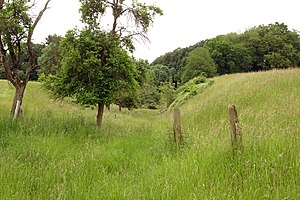Hollow Gauls trenches
|
Hollow Gauls trenches
|
||
|
Hohl "Gaulsgräben", ravine through meadows in the north |
||
| location | south of Otzberg - Ober-Klingen , Darmstadt-Dieburg district , Hesse | |
| surface | 3.8526 ha | |
| Geographical location | 49 ° 48 ' N , 8 ° 53' E | |
|
|
||
| Setup date | May 27, 1959 | |
The hollow "Gaulsgräben" is an extensive natural monument in the municipality of Otzberg , district Ober-Klingen , in the district of Darmstadt-Dieburg , southern Hesse. It was protected by ordinance of May 27, 1959 as a geological natural monument and bird sanctuary.
location
The natural monument "Gaulsgräben" is located about one kilometer south of Ober-Klingen. The cave cut into the loess slopes to the north and has two shorter side valleys. The 3.8526 hectare natural monument is surrounded by fields and partly by fruit trees.
description
The "Gauls trenches" are about 400 meters long, up to 150 meters wide and up to 6 meters deep cut into the loess. Para brown earth and brown earth from loess loam over rocks of the red sandstone are the soil types . The soil at the bottom of the Lösstal is in places shaped by groundwater. The area was used for arable farming in earlier centuries and has been overgrown with trees since around 1900. The forest consists of old oaks, sycamore maples, cherries, ash trees, pines, beeches and stocks of non-local spruce. In the herb layer grow one berry and large two-leaf . From the north a ravine leads through meadows with fruit trees to a hump, which is used as a pasture and which is noticeable by thistles and nitrogen-showing nettle meadows . A loess tap for wild bees and other ground-dwelling insects was created here.
The woody stocks are an important refuge for threatened animal and plant species. As a species on the Red List, the turtledove breeds , as well as the red- backed shrimp , oriole and partridge . In addition, graycatchers , common redstart and warbler species occur.
See also
Individual evidence
- ^ Ordinance on the safeguarding of natural monuments in the Dieburg district. (PDF; 26 kB) The district committee of the Dieburg district, May 27, 1959, accessed on June 8, 2020 .
- ↑ "Environmental Protection" map. BürgerGIS district of Darmstadt-Dieburg. Darmstadt-Dieburg district, accessed on June 8, 2020 .
- ^ A b c Horst Bathon, Georg Wittenberger: The natural monuments of the Darmstadt-Dieburg district with biotope tours. 2nd expanded and completely revised edition. In: District Committee of the Darmstadt-Dieburg District - Lower Nature Conservation Authority, Darmstadt (Hrsg.): Series of publications, Darmstadt-Dieburg district. 2016, ISBN 978-3-00-050136-4 . Pp. 124-126.




